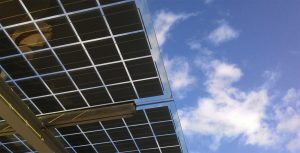One of the earliest improvements in regards to events and sustainability was the option for using significantly less paper during conferences, trade shows, and other meetings. Mobile devices paved the way for event-specific apps, giving attendees access to all of the information they needed without having to print out large packets and handouts.
As ticketing and check-in needs began being handled via mobile devices, tablets, and computers, even fewer printed items were needed. Add to that the ability to produce and display high-quality digital signage and technology made the use of paper at many events almost a thing of the past.
But reducing paper isn’t the only advantage technology has afforded events. Here are just a few other developments that have improved sustainability along the way.
Green Venues
 Many choice destinations have a range of venues that support green building and development. For example, large conference sites like the Mandalay Bay Conference Center in Las Vegas take advantage of ample sunshine through the use of solar panels. This helps produce power for the building, including any event, with a little help from the sun. As solar panels become more capable, additional venues are using the technology to offset the electricity used by some of the largest conferences and trade shows, making almost any event “greener” than it was before.
Many choice destinations have a range of venues that support green building and development. For example, large conference sites like the Mandalay Bay Conference Center in Las Vegas take advantage of ample sunshine through the use of solar panels. This helps produce power for the building, including any event, with a little help from the sun. As solar panels become more capable, additional venues are using the technology to offset the electricity used by some of the largest conferences and trade shows, making almost any event “greener” than it was before.
Other features of green venues can include highly efficient heating and cooling systems, recycling bins throughout the space (some of them don’t even require attendees to sort their trash, thanks to an assist from technology), and even bathroom fixtures that use less water.
Virtual Attendance
 Video conferencing has become more stable over recent years, allowing presenters and attendees to get a high-quality experience even when they aren’t attending the event in person. By limiting the number of people physically in a space, fewer resources are required to support the conference.
Video conferencing has become more stable over recent years, allowing presenters and attendees to get a high-quality experience even when they aren’t attending the event in person. By limiting the number of people physically in a space, fewer resources are required to support the conference.
While this arrangement may not be ideal for trade show focused events, as interacting with vendors may not be plausible, for those concentrated on speakers and presentations, having a virtual component can increase attendance while simultaneously lowering the events carbon footprint. However, advances in virtual reality and augmented reality may expand the capabilities when it comes to virtual events.
Conference goers may be able to fully explore a space as though they were there by combining high definition, 360-degree video with a headset connected to their computer. Essentially, they could enjoy a full virtual tour of a trade show floor, giving them a chance to examine vendor booths and information displays. With augmentation, they could interact with what they are viewing, requesting additional information or taking screenshots to review at a later time.
ChatBots
While not a green technology on the surface, ChatBots may have the capacity to make events more sustainable thanks to their ability to provide information quickly without the need for a person to directly be involved. This can reduce the number of onsite staff members required to support an event and shrink the size of information booths.
Technology in this area is evolving, allowing people to communicate more naturally with these AI-based interfaces. Then, if something beyond the ChatBot’s capabilities happens to arise, the person can be referred to a staff member for further assistance.
Advanced Analytics
 Many event professionals have been keeping data on event attendance and similar metrics for years, but only recently have we been able to fully unlock the power of this information. Data analytics can be used to streamline a conference or trade show and create opportunities to reduce the amount of resources are used and how much waste is created.
Many event professionals have been keeping data on event attendance and similar metrics for years, but only recently have we been able to fully unlock the power of this information. Data analytics can be used to streamline a conference or trade show and create opportunities to reduce the amount of resources are used and how much waste is created.
For example, if an event includes food for attendees, being able to compare the amount of food consumed to previous year’s numbers of people in attendance can help you decide what needs to be provided more accurately. This limits the risk of over-ordering, ensuring only what is actually needed will be brought in.
And More to Come
Technology focused on greater sustainability continues to be developed every day, helping large events, conferences, and trade shows use fewer resources while engaging attendees in new and exciting ways. Applications designed to make local sourcing simpler can contribute to reducing costs associated with bringing in food or finding rental equipment, both of which can be less expensive and better for the environment thanks to the reduced shipping needs. Power consumption on many popular devices are being lowered as everything from televisions and other digital displays to mobile devices are being designed to work more efficiently and require less electricity.
Any event can be made more “green” with a little effort and planning, especially when you choose a venue that already considers sustainability a priority. Then, explore your technology options and see how your event can be made even more efficient and sustainable.
Catherine Reed
Latest posts by Catherine Reed (see all)
- Increase Your Event’s Social Presence by Creating Photo-Worthy Moments - March 6, 2020
- How to Make the Most of Content Production Opportunities at Events - March 3, 2020
- Is Your WiFi Ready for Live-Streaming? - April 25, 2019

